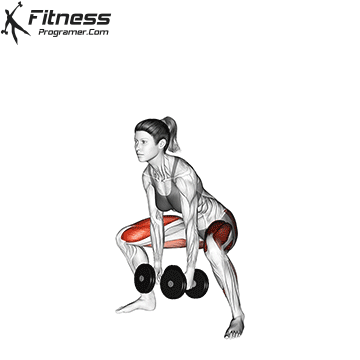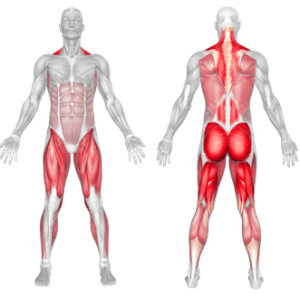Dumbbell Sumo Deadlift Overview
The dumbbell sumo deadlift is a variation of the traditional sumo deadlift exercise that incorporates dumbbells as resistance instead of a barbell. The “sumo” stance refers to the wide stance used in this exercise, with the feet positioned wider than shoulder.
The dumbbell sumo deadlift can be an effective addition to your lower body and overall strength training routine, but it’s essential to perform it correctly to get the most benefit and minimize the risk of injury. Here’s how to perform a dumbbell sumo deadlift:
How to do Dumbbell Sumo Deadlift:

- Setup:
- Stand with your feet wider apart than shoulder-width, with your toes pointing slightly outward. The wider stance is a key characteristic of the sumo deadlift.
- Place a dumbbell on the ground between your feet. You can use one or two dumbbells, depending on your preference and the weight you’re comfortable with.
- Grip the Dumbbells:
- Bend at your hips and knees to lower your body down. Keep your back straight, chest up, and your core engaged.
- Grasp the dumbbells with both hands using an overhand grip (palms facing each other) between your legs.
- Lift:
- As you exhale, stand up by driving through your heels, extending your hips and knees simultaneously. Keep the dumbbells close to your body as you lift them.
- Make sure to maintain a neutral spine throughout the movement. Do not round your lower back.
- Finish:
- At the top of the movement, stand tall with your hips fully extended, and your shoulders back.
- Pause for a moment, and then reverse the movement by bending at your hips and knees to lower the dumbbells back to the ground.
- Control the descent to avoid slamming the weights on the floor.
- Repeat:
- Perform the desired number of repetitions, and then carefully return the dumbbells to the starting position.
Tips:
- Start with a light weight to ensure proper form and gradually increase the weight as you become more comfortable with the movement.
- Keep the dumbbell close to your body throughout the lift to minimize strain on your lower back.
- Maintain a neutral spine and avoid rounding or arching your back.
- Push through your heels when lifting and lowering the weight to engage your hamstrings and glutes effectively.
- Don’t rush the movement; focus on control and proper technique.
Benefits Of Dumbbell Sumo Deadlift
Full-Body Strength:
The dumbbell sumo deadlift is a compound exercise that targets multiple muscle groups simultaneously. It primarily targets the lower body muscles, including the glutes, hamstrings, quadriceps, and adductors, while also involving the muscles of the upper body, such as the lower back, traps, and forearms. This results in improved overall strength.
Increased Muscle Mass:
Because it engages many major muscle groups, the dumbbell sumo deadlift can help stimulate muscle growth throughout your body. It’s particularly effective for building strong and toned legs and glutes.
Functional Strength:
This exercise mimics the movement patterns used in everyday activities like lifting objects from the ground. Therefore, it helps improve functional strength, making daily tasks easier and reducing the risk of injury.
Improved Posture:
Performing the dumbbell sumo deadlift with proper form requires maintaining a neutral spine and a strong core. This can contribute to better posture and reduced risk of lower back pain.
Enhanced Grip Strength:
Since you’re holding onto dumbbells during this exercise, your grip strength will be challenged. This can be especially beneficial if you’re looking to improve your grip for other exercises or activities.
Caloric Burn:
Like all compound movements, the dumbbell sumo deadlift burns a significant number of calories. It can contribute to weight management and fat loss when incorporated into a well-rounded fitness routine and nutrition plan.
Variety in Training:
Adding the dumbbell sumo deadlift to your workout routine can provide variety and prevent boredom. It’s a different take on traditional deadlifts and can help keep your workouts interesting and challenging.
Adaptability:
Dumbbell sumo deadlifts are adaptable to various fitness levels. You can start with lighter weights and progressively increase the load as you get stronger, making it suitable for both beginners and advanced lifters.
Lower Back Health:
When performed with proper form, the dumbbell sumo deadlift can help strengthen the muscles of the lower back, reducing the risk of lower back injuries and discomfort.
Core Activation:
The exercise requires a stable core to support the spine and lift the weight. This can contribute to improved core strength and stability over time.
Dumbbell Sumo Deadlift: Muscles Worked
Here’s a breakdown of the muscles worked during the dumbbell sumo deadlift:

- Glutes (Gluteus Maximus): The glutes are the primary muscles worked during the dumbbell sumo deadlift. They are responsible for extending the hips and driving the movement upward.
- Quadriceps (Quadriceps Femoris): The quadriceps, located at the front of your thighs, are heavily engaged during the lifting phase of the exercise. They are responsible for straightening your knees as you stand up.
- Hamstrings (Hamstring Muscles): The hamstrings, located on the back of your thighs, are also engaged during the lifting phase. They assist in extending the hips and bending the knees.
- Lower Back (Erector Spinae): The erector spinae muscles run along your spine and help support your back. They play a significant role in maintaining a stable spine and preventing rounding or flexing during the exercise.
- Adductors (Inner Thigh Muscles): The adductor muscles of the inner thigh are worked as they help stabilize your legs in the wide sumo stance.
- Core (Abdominals and Obliques): Your core muscles are engaged to stabilize your spine and prevent excessive arching or rounding of the back. This includes the rectus abdominis (front of the core) and the obliques (side of the core).
- Forearms and Grip Strength: Holding onto the dumbbells challenges your forearm muscles and grip strength, which is necessary to control and lift the weights effectively.
- Traps (Trapezius): Your traps, particularly the upper traps, are engaged to help maintain proper posture and shoulder position while holding the dumbbells.
It’s important to note that while these muscles are the primary targets, the dumbbell sumo deadlift is a compound exercise that engages many other stabilizing and supporting muscles as well. Proper form is crucial to maximize the benefits of this exercise and reduce the risk of injury. Always start with a weight that allows you to perform the exercise with good form and gradually increase the load as you become more proficient. If you have any doubts about your form or technique, consider seeking guidance from a fitness professional or personal trainer.
